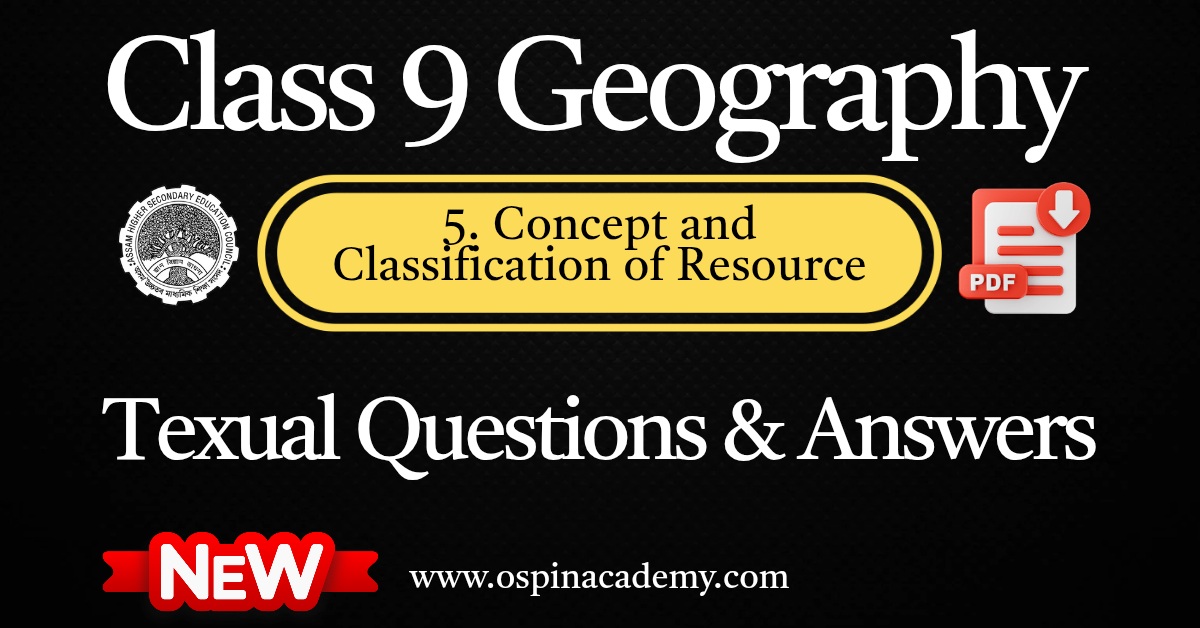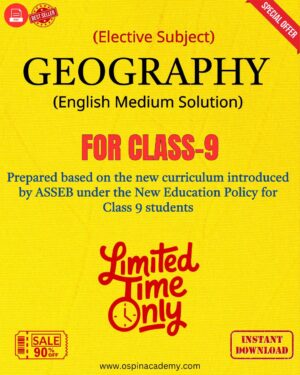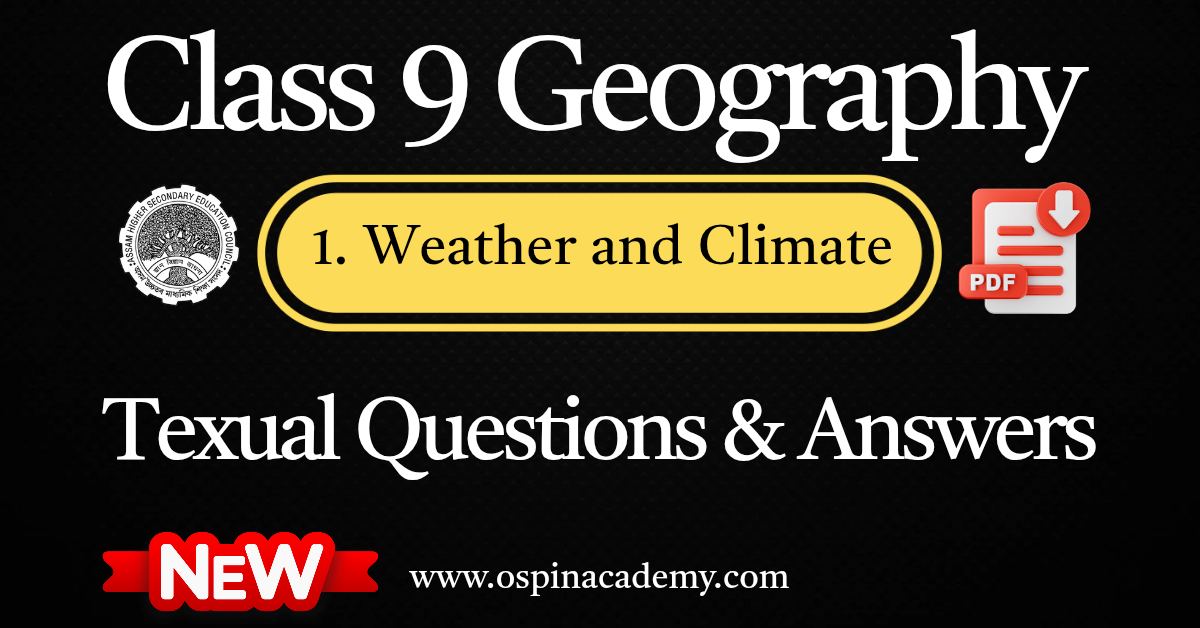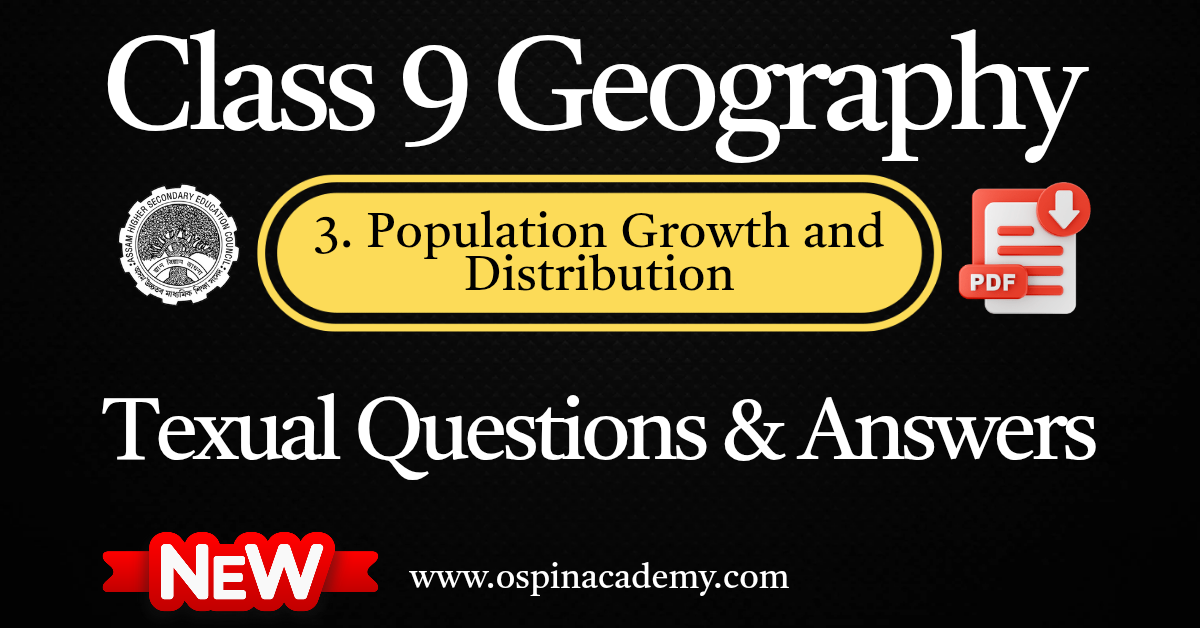Class 9 Geography Chapter 5 – Concept and Classification of Resource Complete Solutions | Assam Board (ASSEB) | Latest Syllabus | English Medium
Class 9 Geography Chapter 5 – Concept and Classification of Resource Complete Solutions (Assam Board – ASSEB – English Medium)
This chapter introduces the concept of resources, highlighting their importance and how they are classified based on origin, availability, and ownership. Students will explore different types of resources such as natural, human-made, renewable, and non-renewable resources. The chapter provides detailed solutions to help understand resource management and conservation.
✅ What you will learn:
- Definition and importance of resources
- Classification of resources by origin—natural and human-made
- Classification by exhaustibility—renewable and non-renewable
- Classification based on ownership—individual, community, national, and international resources
- Significance of sustainable resource management
🎯 Why choose Ospin Academy?
- Comprehensive solutions adhering to the latest Assam Board (ASSEB) syllabus
- Clear, concise English medium explanations for Class 9 students
- Practice questions aiding in effective exam preparation
- Study material aligned with current syllabus standards
- Trusted digital resource facilitating easy learning
Class 9 Geography Elective English Medium | Latest Syllabus Chapter-wise Solutions PDF
Limited Time Offer!
(For Class 9 Geography Elective, English Medium)
Prepare thoroughly for Class 9 Geography Elective with this chapter-wise solutions PDF.
Includes complete, clear, and exam-focused textual solutions as per the latest syllabus.
Ideal for self-study, homework help, and last-minute revision.
Chapter-5
Concept and Classification of Resource
1. What do you mean by resource?
Answer: Resource refers to natural and human-made items that can fulfil the various needs of people. Not everything found in nature is a resource. Only those natural objects that serve some useful purpose for humans are regarded as resources.
2. What are the human factors that play important role in recognising natural elements as resource?
Answer: Living and non-living components of nature remain simply parts of the environment until humans exploit them. Natural elements such as land, water, plants and animals become resources only when people convert them into useful products. Hence, the human element is the primary factor that turns a natural object into a resource. In this context, human-related aspects like cultural values, technology and the economic system are crucial.
(i) Cultural value: Culture strongly influences whether an item is seen as useful. For instance, many forest products and plants exist worldwide that are of little value to most people. But in India, some of these items are highly valued because of their medicinal properties or religious importance. Thus, culture can make a natural item either a resource or simply a part of nature.
(ii) Technology: The degree to which natural elements are transformed into useful products depends on available technology. Extracting and using resources requires technical knowledge and modern methods to exploit them scientifically and develop them properly. Without appropriate technology, resources remain untapped or under-used. For example, certain regions of India are believed to have large oil deposits buried deep underground, but lack of suitable technology makes extraction difficult. In future, when the required technology becomes available, extraction may become feasible.
(iii) Economic system: Resource development also depends heavily on a country’s economic system or its economic viability. For example, India has numerous rivers with abundant water that constitute an important national resource. Yet some regions still suffer severe droughts and floods. Because of the high cost of linking all rivers, their water is not fully utilised. Therefore, the economic system plays a key role in converting a natural item into a useful product.
3. What are the factors that influence the concept of resource?
Answer: Natural and human-made objects capable of satisfying human needs are called resources. Natural elements such as land, water, animals and plants are recognised as resources only when humans use them and consider them useful. It is people who decide whether an element is a resource or not. However, the concept of a resource can change over time and with technological progress. For example, elements of nature accepted as valuable today might once have been unwanted. Before the British arrived in Assam, wild tea plants in Assam’s forests were of little importance. The British recognised their value and began commercial use; tea quickly became popular in the West and tea cultivation was established commercially, bringing economic growth to the region. Likewise, oil was present in Assam long ago but people did not know its use and did not value it economically. Today oil is regarded as a valuable resource and its extraction has improved the state’s economy. This shows that something neglected in the past may become valuable later as social, cultural and economic conditions change. In other words, the idea of a resource and its importance vary with cultural, economic and technological developments over time.
4. Discuss the effects of the growing population on resources.
Answer: People use resources to meet their various needs. Thus, as population grows, demand for different resources also rises. But many resources are non-renewable and cannot be increased simply because population rises. Consequently, a large population leads to limited resource supply, which in turn causes higher prices for resources and their products.
It also forces people to seek alternatives. With declining availability of fossil fuels like coal, oil and gas, alternatives such as hydro-electric or nuclear power were explored. When it became clear that hydro-electric and nuclear power generation can cause considerable environmental harm, attention shifted to renewable energy sources like solar, wind, tidal, biomass and geothermal energy. Finally, intensive use of resources by a large population results in greater waste and increased environmental pollution. Thus, high population exerts negative pressure on the development and use of resources.
5. What is natural resource?
Answer: Natural resources are products of nature that are useful to humans or can be used to satisfy various human needs. e.g. air, land, water, plants, etc.
6. Give few examples of man-made resources.
Answer: Some examples of man-made resources are aluminium, petroleum (refined products), steel, tea (processed), cement, cars, trains, aeroplanes, etc.
7. What is human resource?
Answer: Human resource denotes the capabilities of people to meet needs and to provide better services; in other words, the potential of human beings to perform work and contribute to development.
8. What is meant by renewable resource? Give few examples of it.
Answer: Renewable resources are those supplied by nature that can be used repeatedly and replenished naturally. e.g. air, sunlight, wind, tides, hot springs, biomass, etc.
9. Name few non-renewable resources.
Answer: Some non-renewable resources are coal, petroleum, natural gas, certain types of wood (from slow-growing forests), and various minerals.
10. Why should wastage of resource be checked?
Answer: Wastage of resources should be avoided for the following reasons:
(i) Limited resource: Wastage reduces the available supply. If resources continue to be used at present rates, many will be exhausted in the near future.
(ii) Environmental pollution: Wastage of resources can cause environmental pollution, which may lead to serious health hazards.
(iii) Progress-oriented: No country can progress without resources. There is an urgent need to conserve existing resources.
Therefore, wastage of resources is not acceptable.
11. Think over and write how extraction and use of resources can degrade the environment.
Answer: Resources are essential for a nation’s economic development, but improper extraction and use can produce several harmful effects. The most serious impact is on the environment, which becomes polluted and deteriorates over time. This occurs in the following ways:
(i) Burning fossil fuels such as coal, petroleum and natural gas in factories and vehicles emits harmful gases into the atmosphere, causing air pollution. In fact, vehicle emissions are a major source of pollution.
(ii) Many industrial plants that use hydro-electricity or burn coal or petroleum for power generation release large quantities of smoke and gases into the air, contributing to environmental pollution.
(iii) Improper extraction of minerals like coal and iron spreads mineral dust widely, degrading the surrounding environment.
(iv) Use of atomic materials for power generation and production of nuclear weapons also pollutes the environment; air and water near such facilities can become contaminated despite precautions.
(v) Wastewater discharged from factories processing various minerals contains pollutants that contaminate water bodies and the plants that absorb such polluted water.
12. What are the sources of natural resources available in your locality? How have the people used and misused the sources of these resources? Write how the misuse can be checked.
Answer: In my locality, the main natural resources available are land, water, forests, and air. These resources are used by people in various ways. Land is used for agriculture, housing, and construction of roads and buildings. Water is utilised for drinking, irrigation, and domestic purposes. Forests provide timber, fuel, fruits, and raw materials for different uses, while air supports the survival of all living beings.
However, these valuable resources are often misused by people. Excessive cutting of trees for fuel and construction has led to deforestation. Overuse and pollution of water sources through dumping of waste and chemicals have made clean water scarce. Unplanned construction and overuse of land have caused soil erosion and loss of fertility. Air pollution from vehicles and burning of waste has also degraded the environment.
To check such misuse, people must adopt responsible practices. Trees should be planted regularly to replace the ones cut down. Water should be used carefully and kept free from pollution. Land should be used according to proper planning and soil conservation methods should be followed. Steps should also be taken to control air pollution by limiting the use of vehicles and avoiding burning of waste. Public awareness and strict government regulations can help conserve and protect these natural resources for the future.
Class 9 Geography Chapter 5 – Frequently Asked Questions
Get Free NCERT PDFs
If you want to download free PDFs of any chapter, click the link below and join our WhatsApp group:




